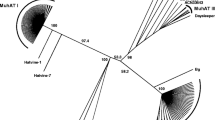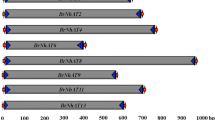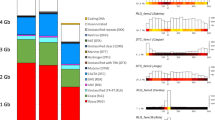Abstract
Genome-wide analyses of repetitive DNA suggest a significant impact particularly of transposable elements on genome size and evolution of virtually all eukaryotic organisms. In this study, we analyzed the abundance and diversity of the hAT transposon superfamily of the sugar beet (B. vulgaris) genome, using molecular, bioinformatic and cytogenetic approaches. We identified 81 transposase-coding sequences, three of which are part of structurally intact but nonfunctional hAT transposons (BvhAT), in a B. vulgaris BAC library as well as in whole genome sequencing-derived data sets. Additionally, 116 complete and 497 truncated non-autonomous BvhAT derivatives lacking the transposase gene were in silico-detected. The 116 complete derivatives were subdivided into four BvhATpin groups each characterized by a distinct terminal inverted repeat motif. Both BvhAT and BvhATpin transposons are specific for species of the genus Beta and closely related species, showing a localization on B. vulgaris chromosomes predominantely in euchromatic regions. The lack of any BvhAT transposase function together with the high degree of degeneration observed for the BvhAT and the BvhATpin genomic fraction contrasts with the abundance and activity of autonomous and non-autonomous hAT transposons revealed in other plant species. This indicates a possible genus-specific structural and functional repression of the hAT transposon superfamily during Beta diversification and evolution.






Similar content being viewed by others
References
Al-Dous EK, George B, Al-Mahmoud ME, Al-Jaber MY, Wang H, Salameh YM, Al-Azwani EK, Chaluvadi S, Pontaroli AC, Debarry J, Arondel V, Ohlrogge J, Saie IJ, Suliman-Elmeer KM, Bennetzen JL, Kruegger RR, Malek JA (2011) De novo genome sequencing and comparative genomics of date palm (Phoenix dactylifera). Nat Biotechnol 29:521–527
Altinkut A, Kotseruba V, Kirzhner VM, Nevo E, Raskina O, Belyayev A (2006) Ac-like transposons in populations of wild diploid Triticeae species: comparative analysis of chromosomal distribution. Chromosom Res 14:307–317
Arumuganathan K, Earle ED (1991) Nuclear DNA content of some important plant species. Plant Mol Biol Rep 9:208–218
Benjak A, Forneck A, Casacuberta JM (2008) Genome-wide analysis of the “cut-and-paste” transposons of grapevine. PLoS One 3:e3107
Benjak A, Boué S, Forneck A, Casacuberta JM (2009) Recent amplification and impact of MITEs on the genome of grapevine (Vitis vinifera L.). Genome Biol Evol 20:75–84
Bennetzen JL (2005) Transposable elements, gene creation and genome rearrangement in flowering plants. Curr Opin Genet Dev 15:621–627
Birney E, Clamp M, Durbin R (2004) GeneWise and Genomewise. Genome Res 14:988–995
Cavallini A, Natali L, Zuccolo A, Giordani T, Jurman I, Ferrillo V, Vitacolonna N, Sarri V, Cattonaro F, Ceccarelli M, Cionini PG, Morgante M (2010) Analysis of transposons and repeat composition of the sunflower (Helianthus annuus L.) genome. Theor Appl Genet 120:491–508
Crooks GE, Hon G, Chandonia JM, Brenner SE (2004) WebLogo: a sequence logo generator. Genome Res 14:1188–1190
de Freitas OrtizM, Lorenzatto KR, Corrêa BR, Loreto EL (2010) hAT transposable elements and their derivatives: an analysis in the 12 Drosophila genomes. Genetica 138:649–655
De Keukeleire P, De Schepper S, Gielis J, Gerats T (2004) A PCR-based assay to detect hAT-like transposon sequences in plants. Chromosom Res 12:117–123
Desel C (2002) Chromosomale Lokalisierung von repetitiven und unikalen DNA-Sequenzen durch Fluoreszenz- in situ- Hybridisierung in der Genomanalyse bei Beta-Arten. Dissertation Christian-Albrechts-University Kiel, Germany
Drummond AJ, Ashton B, Cheung M, Heled J, Kearse M, Moir R, Stones-Havas S, Thierer T, Wilson A (2009) Geneious v4.7. Available from http://www.geneious.com/
Du J, Grant D, Tian Z, Nelson RT, Zhu L, Shoemaker RC, Ma J (2010) SoyTEdb: a comprehensive database of transposable elements in the soybean genome. BMC Genomics 11:113
Fedoroff N, Wessler S, Shure M (1983) Isolation of the transposable maize controlling elements Ac and Ds. Cell 35:235–242
Feschotte C, Pritham EJ (2007) DNA transposons and the evolution of eukaryotic genomes. Annu Rev Genet 41:331–368
Feschotte C, Jiang N, Wessler SR (2002) Plant transposable elements: where genetics meets genomics. Nat Rev Genet 3:329–341
Feschotte C, Swamy L, Wessler SR (2003) Genome-wide analysis of mariner-like transposable elements in rice reveals complex relationships with stowaway miniature inverted repeat transposable elements (MITEs). Genetics 163:747–758
Finnegan DJ (1989) Eukaryotic transposable elements and genome evolution. Trends Genet 5:103–107
Flavell RB, Bennett MD, Smith JB, Smith DB (1974) Genome size and the proportion of repeated nucleotide sequence DNA in plants. Biochem Genet 12:257–269
Fujino K, Sekiguchi H, Kiguchi T (2005) Identification of an active transposon in intact rice plants. Mol Genet Genomics 273:150–157
Fujino K, Matsuda Y, Sekiguchi H (2009) Transcriptional activity of rice autonomous transposable element Dart. J Plant Physiol 166:1537–1543
Gindullis F, Dechyeva D, Schmidt T (2001) Construction and characterization of a BAC library for the molecular dissection of a single wild beet centromere and sugar beet (Beta vulgaris) genome analysis. Genome 44:846–855
Hall TA (1999) BioEdit: a user-friendly biological sequence alignment editor and analysis program for windows 95/98/NT. Nucleic Acids Symp Ser 41:95–98
Hehl R, Nacken W, Krause A, Saedler H, Sommer H (1991) Structural analysis of Tam3, a transposable element from Antirrhinum majus, reveals homologies to the Ac element from maize. Plant Mol Biol 16:369–371
Heitkam T, Schmidt T (2009) BNR—a LINE family from Beta vulgaris- contains a RRM domain in open reading frame 1 and defines a L1 sub-clade present in diverse plant genomes. Plant J 59:872–882
Henk AD, Warren RF, Innes RW (1999) A new Ac-like transposon of Arabidopsis is associated with a deletion of the RPS5 disease resistance gene. Genetics 151:1581–1589
Holligan D, Zhang X, Jiang N, Pritham EJ, Wessler SR (2006) The transposable element landscape of the model legume Lotus japonicus. Genetics 174:2215–2228
Huang J, Zhang K, Shen Y, Huang Z, Li M, Tang D, Gu M, Cheng Z (2009) Identification of a high frequency transposon induced by tissue culture, nDaiZ, a member of the hAT family in rice. Genomics 93:274–281
Jacobs G, Dechyeva D, Menzel G, Dombrowski C, Schmidt T (2004) Molecular characterization of Vulmar1, a complete mariner transposon of sugar beet and diversity of mariner- and En/Spm-like sequences in the genus Beta. Genome 47:1–10
Kunze R, Weil CF (2002) The hAT and CACTA superfamily of plant transposons. In: Craig NL (ed) Mobile DNA. ASM Press, Washington, DC, pp 565–610
Kunze R, Stochaj U, Laufs J, Starlinger P (1987) Transcription of transposable element Activator (Ac) of Zea mays L. EMBO J 6:1555–1563
Lange C, Holtgräwe D, Schulz B, Weisshaar B, Himmelbauer H (2008) Construction and characterization of a sugar beet (Beta vulgaris) fosmid library. Genome 51:948–951
Macas J, Koblízková A, Neumann P (2005) Characterization of Stowaway MITEs in pea (Pisum sativum L.) and identification of their potential master elements. Genome 48:831–839
McClintock B (1947) Cytogenetic studies of maize and neurospora. Carnegie Inst. Washington Year Book, pp 146–152
McGrath JM, Shaw RS, de los Reyes BG, Weiland JJ (2004) Construction of a sugar beet BAC library from a hybrid with diverse traits. Plant Mol Biol Rep 22:23–28
Menzel G, Dechyeva D, Keller H, Lange C, Himmelbauer H, Schmidt T (2006) Mobilization and evolutionary history of miniature inverted-repeat transposable elements (MITEs) in Beta vulgaris L. Chromosom Res 14:831–844
Menzel G, Dechyeva D, Wenke T, Holtgräwe D, Weisshaar B, Schmidt T (2008) Diversity of a complex centromeric satellite and molecular characterization of dispersed sequence families in sugar beet (Beta vulgaris). Ann Bot 102:521–530
Moon S, Jung KH, Lee DE, Jiang WZ, Koh HJ, Heu MH, Lee DS, Suh HS, An G (2006) Identification of active transposon dTok, a member of the hAT family, in rice. Plant Cell Physiol 47:1473–1483
Moreno-Vázquez S, Ning J, Meyers BC (2005) hATpin, a family of MITE-like hAT mobile elements conserved in diverse plant species that forms highly stable secondary structures. Plant Mol Biol 58:869–886
Pritham EJ, Zhang YH, Feschotte C, Kesseli RV (2003) An Ac-like transposable element family with transcriptionally active Y-linked copies in the white campion, Silene latifolia. Genetics 165:799–807
Rubin E, Lithwick G, Levy AA (2001) Structure and evolution of the hAT transposon superfamily. Genetics 158:949–957
Saghai-Maroof MA, Soliman KM, Jorgensen RA, Allard RW (1984) Ribosomal DNA spacer-length polymorphisms in barley: mendelian inheritance, chromosomal location, and population dynamics. Proc Natl Acad Sci USA 81:8014–8018
Sambrook J, Fritsch EF, Maniatis T (1989) Molecular cloning: a laboratory manual, 2nd edn. Cold Spring Harbor Laboratory Press, New York
Schmidt T, Schwarzacher T, Heslop-Harrison JS (1994) Physical mapping of rRNA genes by fluorescent in situ hybridization and structural analysis of 5S rRNA genes and intergenic spacer sequences in sugar beet (Beta vulgaris). Theor Appl Genet 88:629–636
Schwarzacher T, Heslop-Herrison JS (1991) In situ hybridization to plant telomeres using synthetic oligomeres. Genome 34:317–323
Schwarzacher T, Heslop-Herrison JS (2000) Practical In situ hybridization. BIOS Scientific Publishers, Oxford, p 60
Takagi K, Maekawa M, Tsugane K, Iida S (2010) Transposition and target preferences of an active nonautonomous DNA transposon nDart1 and its relatives belonging to the hAT superfamily in rice. Mol Genet Genomics 284:343–355
Tamura K, Dudley J, Nei M, Kumar S (2007) MEGA4: molecular evolutionary genetics analysis (MEGA) software version 4.0. Mol Biol Evol 24:1596–1599
Vicient CM (2010) Transcriptional activity of transposable elements in maize. BMC Genomics 11:601
Vicient CM, Suoniemi A, Anamthawat-Jónsson K, Tanskanen J, Beharav A, Nevo E, Schulmann AH (1999) Retrotransposon BARE-1 and its role in genome evolution in the genus Hordeum. Plant Cell 11:1769–1784
Vollbrecht E, Duvick J, Schares JP, Ahern KR, Deewatthanawong P, Xu L, Conrad LJ, Kikuchi K, Kubinec TA, Hall BD, Weeks R, Unger-Wallace E, Muszynski M, Brendel VP, Brutnell TP (2010) Genome-wide distribution of transposed dissociation elements in maize. Plant Cell 22:1667–1685
Wicker T, Sabot F, Hua-Van A, Bennetzen JL, Capy P, Chalhoub B, Flavell A, Leroy P, Morgante M, Panaud O, Paux E, SanMiguel P, Schulman AH (2007) A unified classification system for eukaryotic transposable elements. Nat Rev Genet 8:973–982
Xu Z, Dooner HK (2005) Mx-rMx, a family of interacting transposons in the growing hAT superfamily of maize. Plant Cell 17:375–388
Yang G, Weil CF, Wessler SR (2006) A rice Tc1/mariner-like element transposes in yeast. Plant Cell 18:2469–2478
Zhang X, Wessler SR (2004) Genome-wide comparative analysis of the transposable elements in the related species Arabidopsis thaliana and Brassica oleracea. Proc Natl Acad Sci USA 101:5589–5594
Zhang X, Jiang N, Feschotte C, Wessler SR (2004) PIF- and Pong-like transposable elements: distribution, evolution and relationship with Tourist-like miniature inverted-repeat transposable elements. Genetics 166:971–986
Acknowledgments
We thank Ines Walter for excellent technical assistance. This work has been funded by the “Verbundprojekt GABI BeetSeq: Erstellung einer Referenzsequenz für das Genom der Zuckerrübe (Beta vulgaris)”, FKZ 0315069A and 0315069B (to H.H. and B.W.).
Author information
Authors and Affiliations
Corresponding author
Rights and permissions
About this article
Cite this article
Menzel, G., Krebs, C., Diez, M. et al. Survey of sugar beet (Beta vulgaris L.) hAT transposons and MITE-like hATpin derivatives. Plant Mol Biol 78, 393–405 (2012). https://doi.org/10.1007/s11103-011-9872-z
Received:
Accepted:
Published:
Issue Date:
DOI: https://doi.org/10.1007/s11103-011-9872-z




